In this Good Practice Note, Hemendra K Pratihari reflects on the evolution of Farmer Producer Companies under the Agriculture Production Cluster Programme implemented in Odisha.
CONTEXT
Small and marginal farmers constitute about 83% of the farming community in the Indian state of Odisha. According to the National Sample Survey (NSS) Report 2019, the average monthly income per agricultural household is INR 5,380 from crop production and rearing of small ruminants (REF). The average size of marginal land holding is 0.5 hectares. In order to improve the village economy, enhance agricultural productivity and increase the income of farmers it was necessary to collectivize the farmers in this area so as to realize the potential of their resources and help them benefit from the economies of scale. In November 2018, the Government of Odisha initiated a project named ‘Agriculture Production Cluster (APC)’, which aimed to empower one lakh women farmers by doubling their income and ensuring economic sustainability. This was a collaborative effort by the Department of Agriculture and Farmers’ Empowerment, Department of Mission Shakti, Bharat Rural Livelihoods Foundation (BRLF), Bill and Melinda Gates Foundation (BMGF), Professional Assistance for Development Action (PRADAN), and 16 partner CSOs (Civil Society Organisations). Both BRLF and BMGF are supporting the expenses of CSO partners.
OBJECTIVES AND REACH
The project focused on collectivizing farmers into Producer Groups (PGs) and Farmer Producer Companies (FPC) in 40 blocks spread over 12 districts – Mayurbhanj, Keonjhar, Dhenkanal, Rayagada, Kalahandi, Kandhamal, Koraput, Sambalpur, Jharshuguda, Boudh, Balangir and Nuapada – where women farmers will practice synchronized farming and establish market linkages. Subsequently, this program was expanded to 33 more blocks with support from the District Mineral Foundation (DMF), reaching an additional 1.19 lakh small and marginal farmers. The project also aimed at promoting livestock rearing which would contribute to an essential component of the village economy. These were being supported by the creation of livelihood support infrastructures such as irrigation, goat and backyard poultry sheds, and fruit tree plantation along with linkage to relevant market players. Through the APC project, 30 FPCs were formed where 42,000 women farmers from 932 PGs are currently mobilized as shareholders in the FPCs. These FPCs are registered under the Companies Act, enabling shareholders to have better access to the market, input and resources, credit, technologies, and risk mitigation strategies (Box 1).
|
Box 1: Why FPCs? |
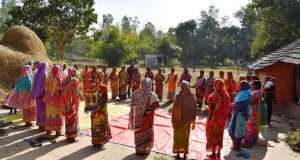 Visioning exercise of PG members
Visioning exercise of PG members
ROLE OF STAKEHOLDERS
PRADAN: PRADAN (https://www.pradan.net/) is playing the role of lead agency in the state supporting and coordinating the APC program as well as FPCs by bringing together various stakeholders onto one platform. PRADAN builds capacities of CSO partners to facilitate the farmers on synchronized farming of the crops identified for the season by the FPC. In order to build an ecosystem for the sustainability of FPCs, PRADAN has been providing training support to CSO partners and FPCs which include mobilization of farmers, compliance of FPC, building capacities of FPC functionaries on governance and financial management, development of viable business plans, connecting with the bank and financial institutions for credit linkage, product development, and facilitation of forward and backward market linkages from pre-production to marketing.
FPC: FPC as an institution is mainly women-owned and women-managed where they are developed for connecting with various stakeholders.
CSO Partners: CSOs support formation and strengthening of PGs and FPC in the selected blocks; nurture the collectives for crop planning and facilitate capacity development of FPCs for adopting modern and sustainable farming in a synchronized manner. They also groom the Agri-Entrepreneurs (AESs) to play their role effectively (discussed later in the document) and help set up efficient market ecosystems around APCs.
Government: The government agencies, apart from providing necessary finance to the APC program, support convergence of relevant schemes in the identified areas. The government also plays an important role in reviewing and monitoring the performance of the programme and takes appropriate measures to deal with the emerging challenges.
GOOD PRACTICES
Analysing the context and setting up micro-production clusters
Seasonal crops are identified by the FPCs and PGs based on smallholder suitability, agroecological compatibility, and market demand for the crops (Fig. 1). Synchronizing production on a scale creates a marketable surplus and builds an ecosystem to provide various services required for the farmers in a sustained manner with the increased scale of operation, the following critical gaps were identified in the pre-production, production, and post-production stages.
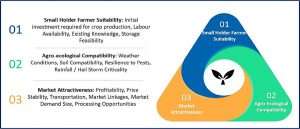 Figure 1: Three-dimensional approach of APC
Figure 1: Three-dimensional approach of APC
These include:
- maintenance of the quality of crop production;
- monitoring crop growth;
- lack of improved package of practices;
- coping with climate change;
- sorting and grading;
- adoption of advanced technologies;
- standard packaging; and
- ensuring timely market linkages.
 Aggregation of watermelon, done at a larger scale (for marketing)
Aggregation of watermelon, done at a larger scale (for marketing)
To address these challenges, PRADAN and other CSO partners have been providing strategic linkages with the government, private players, markets, financial institutions, agriculture research stations, etc. Training on the Package of Practices (PoP) for crops was provided to educate the local farmers to shift from subsistence farmers to commercial farmers. The FPC initiates the planning and execution of seasonal crops, provides doorstep delivery of agricultural inputs, and creates a forum where farmers share their experiences and concerns related to crop production and market linkages. Various markets were explored with farmers in regional and terminal markets so as to sensitize them to the importance of synchronized production and marketing. Market explorations are done in order to understand crop demand, variety, quality, size, colour, and quantity. Training is also provided to farmers on grading and sorting vegetable crops to maintain the quality of a crop with market demand in mind. Field trials, demonstrations, and exposure visits of women farmers are conducted which help them to learn the significance of developing a sustainable organization of their own and catering to the aggregation needs of farmers.
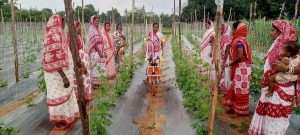 Wheel-based power sprayer to reduce the drudgery of women farmers and improve crop yield
Wheel-based power sprayer to reduce the drudgery of women farmers and improve crop yield
Defining the scale of operation and arriving at the product mix
FPC provides certain services such as agri-inputs, establishing output market linkages, ensuring access to post-harvest structures, and providing technological solutions to its shareholders (women farmers). Many activities and services change with the need of the market, the type of competition for products in the market, and other factors related to the business. In our experience, working with 3,000 women farmers per block, we learned that a single crop cannot be considered beyond a certain threshold level. Hence, a variety of crops are important to balance the crop portfolios that can provide better income to the farmers.
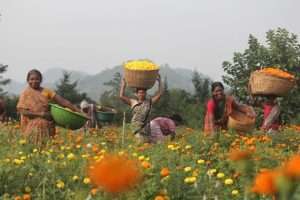 Diversification to marigold cultivation
Diversification to marigold cultivation
Over the years, we realized that producing crops (perishable) from more than 150-200 acres is difficult to sell within a radius of 200 km. For example, Mahila Pragati Farmer Producer Company Ltd in the Kolnara block of Rayagada district facilitated by PRADAN is primarily a brinjal-based FPC that has diversified to marigold as a potential second crop with climate suitability as well as market demand. The small and marginal farmers are encouraged to consider Backyard Poultry (BYP) and Goat Rearing as a supplemental avenue to boost their incomes.
Convergence among departments for supporting institution-building and asset creation of FPC
Several government agencies and a few CSOs have collaborated for this initiative. These include the Department of Agriculture and Farmers’ Empowerment, Directorate of Horticulture, Odisha Lift Irrigation Corporation (OLIC), Odisha Agro-Industry Corporation (OAIC), Agricultural Promotion and Investment Corporation of Odisha Limited (APICOL), MGNREGA, Mission Shakti, Fisheries and Animal Resources, ST & SC Development, District Mineral Foundation (DMF), and Odisha Mineral Bearing Areas Development Corporation (OMBADC). Their collaboration, especially in supporting women-managed institutions, have contributed to enhancing the livelihoods of marginalized communities.
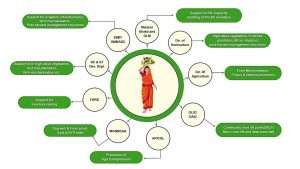 Figure 2: Convergence in the APC Programme
Figure 2: Convergence in the APC Programme
Mission Shakti whose vision is to empower Self-Help Groups is supporting the institution-building cost of PGs and FPCs. It is giving Rs. 61.5 lakhs per FPC for a period of five years. Several costs are incurred for various purposes such as the registration process, initial set-up cost, salaries of the CEO, accountant, and other overheads such as electricity, office rent, etc. In the initial period, FPOs are not able to recover all these costs from the business. Later as the business advances and evolves it will earn more revenue and be able to cover such costs.
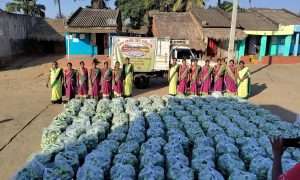 Marketing of brinjal through the FPC
Marketing of brinjal through the FPC
Under the APC project, 27,604 acres of irrigation potential have been created benefitting 24,466 farmers mobilizing resources from OLIC, OAIC, DMF, OMBADC, and MGNREGS. At present, 60,707 farmers have access to farm mechanization. Farmers availed access to power tiller, tractor, sprayer, ridge, weeder, pump set, rotavator, etc., from Common Facilitation Centres managed by producer groups. Improved technologies such as trellis, drip, mulching, and soil-less nurseries, are promoted to increase productivity. With the use of these farm implements and technologies under the program, the struggle of women farmers who have to deal with extreme physical hardships while weeding, intercultural operations, and spraying pesticides have been reduced, and they are able to increase the crop area for cultivation.
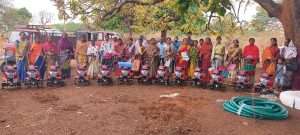 Power tiller distribution through the Horticulture Department
Power tiller distribution through the Horticulture Department
So far, 41 pack houses and 72 storage structures have been created for transit storage of farm produce with support from the Department of Horticulture. The project resulted in the creation of 16,155 acres of plantation areas with fruit-bearing trees benefitting 17,871 families to enhance their livelihoods. In order to generate multiple income sources and provide supplementary income to the farmers’ livelihood, 10,862 BYP sheds and 10,326 goat sheds have been constructed in order to raise goats and hens for commercial farming.
Collaborating with value chain enablers
Ecosystem linkages have been developed with potential buyers from local and distant markets who are regularly procuring from the FPCs (Figure 3). The network has a wide spread of 314 regular buyers in Odisha and nearby states. Additionally, private companies have been linked for input procurement and as solution providers for production and post-harvest technology, output marketing, and finance. There has been collaboration with private players, such as S4S Technologies, to understand the principles of value addition in Ginger so that the FPC can develop value-added products for global markets by establishing primary and secondary processing units.
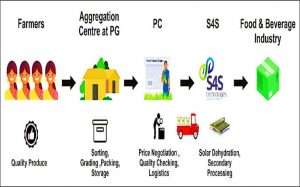 Figure 3: Processes followed in aggregation and marketing of ginger to S4S Technologies
Figure 3: Processes followed in aggregation and marketing of ginger to S4S Technologies
Agri-Entrepreneurs (AE) are systematically selected from the local area and groomed to engage with targeted families in collaboration with FPCs to adopt improved practices, help get inputs, and help them with primary-level grading, sorting, and packaging as well as farm mechanisation services.
For Agriculture Entrepreneurship promotion, the Agricultural Promotion & Investment Corporation of Odisha Limited (APICOL) is implementing the program in partnership with PRADAN. APICOL invites applications through newspaper advertisements for APC project blocks. Both men and women from various areas – in the age group of 18 to 45 years with a minimum educational qualification of 9th standard and the willingness to invest on their own in agri enterprises – are encouraged to apply for the program. A selection committee comprising Block Technical Team (BTT) members under the chairpersonship of the Chief District Agriculture Officer selects the AEs through written tests and interviews conducted at the block level to assess the entrepreneurial abilities of applicants. After two training phases (total of 38 days), these candidates undergo a year-long incubation. During incubation, each AE is supported to prepare a business plan to set up the enterprises they had chosen in order to understand the demands of agricultural services in their cluster. They are linked to several schemes of the government that can potentially provide them grants and bank loans and are supported to fulfil all the regulatory requirements during this period. They also get Rs. 5,000 per month as support during the incubation period of 12 months. The role of PRADAN is to design and facilitate the intervention across the selection, training, and incubation of AEs.
OUTCOMES AND IMPACT
With value chain-based, technology-driven engagement along with human processes we see that family numbers increase along with coverage in the area. The growth in crop coverage in acreage from 2019-20 to 2021-22 is cited in the following infographics (Figure 4).
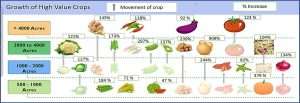 Figure 4: Growth in crop coverage (2019-20 to 2021-22)
Figure 4: Growth in crop coverage (2019-20 to 2021-22)
The following graph (Fig. 5) depicts the year-wise growth of the area and the number of farmers from 2019-20 to 2021-22.
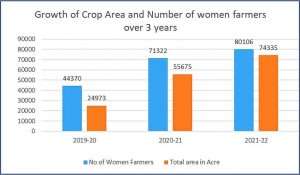 Figure 5: Growth of crop area and number of women farmers over three years. The total area covers vegetables, oilseeds, pulses, and aromatic/indigenous high-value paddy.
Figure 5: Growth of crop area and number of women farmers over three years. The total area covers vegetables, oilseeds, pulses, and aromatic/indigenous high-value paddy.
The average income of farmers was recorded at Rs 46,585 from both agriculture and livestock activity during 2021-22 against the baseline income of Rs 21,877.
The business turnover trend of Mahila Pragati FPC is presented in Figure 6.
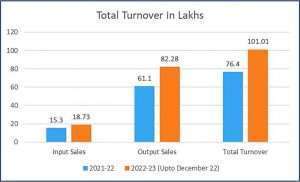 Figure 6: Progress of Mahila Pragati FPS
Figure 6: Progress of Mahila Pragati FPS
CHALLENGES
The farmers are mostly small and marginal in these districts of Odisha. They own fragmented lands that are inequitably distributed and generate low returns. Due to this they were unable to meet the marketable surplus and have limited participation in the market. Collectivization of farmers in the form of FPCs supported minimizing the scale disadvantages faced by small and marginal farmers, thus improving their bargaining power. Contextualizing for smallholder production systems at a critical threshold level and following bottom-up planning and a market-linked approach through synchronized production helped in expanding the cluster.
Creation and use of irrigation sources, orchard development, improved livestock rearing, farm mechanization, and other livelihood assets are critical factors for doubling the farmer’s income. Linking marginal and smallholder farmers with markets, partnerships and convergence with government departments, CSOs, and private market players helped transform farming into an agribusiness.
Coordination of varied stakeholders in a project of this scale is not that easy. A coordination committee at the state level is headed by the Principal Secretary, Dept of Agriculture and Farmers’ Empowerment; at the district level by the District Collector; at the block level by the Block Development Officer. This committee also includes members from other departments at each node and CSO representatives. Periodically they review the program and take course correction measures. It also ensures convergence of various schemes and timely allocation of necessary resources.
CONCLUSION
An FPC requires a minimum incubation period of 4-5 years to stabilize its production, address market demands, and expand its business operations. When it comes to strengthening FPCs, short-term support is found to be counterproductive as this will not help achieve inclusive agricultural growth and income enhancement. A minimum of five years of experience with handholding is required to establish better governance and management of FPCs and for them to become self-sustainable.
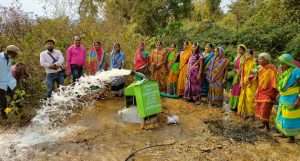 Convergence of micro river lift irrigation through Odisha Agro-Industry Corporation (OAIC)
Convergence of micro river lift irrigation through Odisha Agro-Industry Corporation (OAIC)
The APC project has reached out successfully to many villages as there is an engagement of multiple stakeholders, such as government, donors, private players, CSOs, market agents, financial institutions, as well as research institutions. This collaboration with stakeholders is critical as it helps in mobilizing farmers, accessing government schemes, mobilizing resources, organizing knowledge and skill development, and establishing market linkages.
In order to grow a business robustly, an FPC needs to prepare a business plan from time to time to track progress. A business plan helps the FPC to understand and clarify the business strategy, identify barriers to progress, find alternatives, and help to reach the desired goals, including the operations, financial aspects, marketing, and sales.
A well-functioning FPC is a viable option for addressing the economic risks of farmers and supporting them in terms of scale, crop diversification, potential price risks, and bargaining power.
 Hemendra K Pratihari is a development professional having more than 18 years of grassroots experience working with PRADAN. He can be reached at email: hemendrapratihari@pradan.net
Hemendra K Pratihari is a development professional having more than 18 years of grassroots experience working with PRADAN. He can be reached at email: hemendrapratihari@pradan.net

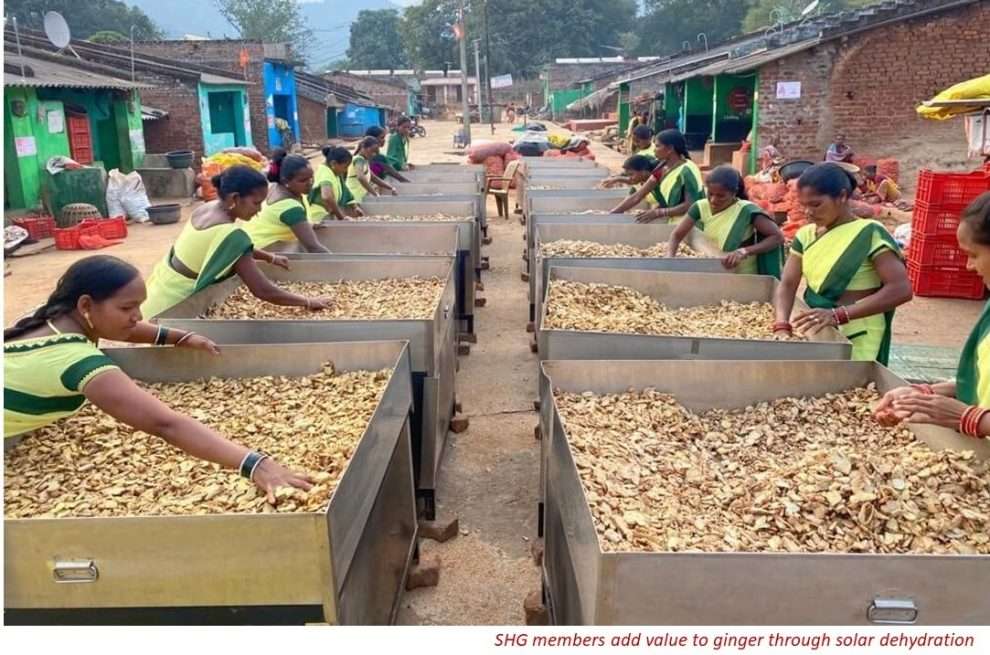
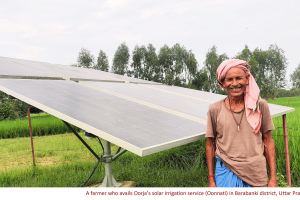
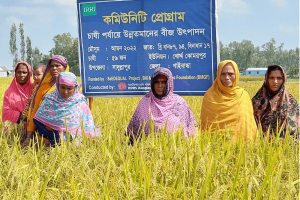
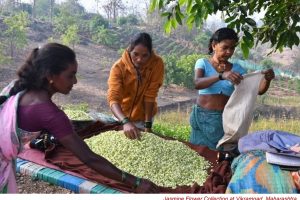
A very good effort by all those associated with this FPC especially PRADAN benefitting thousands of small and marginal farmers. The beauty of this project is in analyzing the existing situation and setting up of micro production clusters and in pooling of resources from several participating institutions to enhance the scale of operation.
It would have been better if the author gave details on the net benefit each farmer got over a period of time rather than income alone.
These types of projects need more time than expected to reach the stage of financial sustainability. Even if the project involves an expenditure of about Rs one crore in the initial years directly benefiting about 25000 families, it is worth it.
Congratulations to the author Shri Hemendra K Pratihari for sharing this good practice note which enabled the small and marginal farmers to increase their income and also in increasing the production of several crops. Thanks to AESA for making such a rich experience available to us.
“This good practice note by Hemendra K Pratihari on practices in strengthening women FPOs was a good read. The highlights were convergence, diversification and empowerment on technical skills as well as marketing aspects. The blog would have been much enlightening if the pathways of building up leadership and risk resilient behaviour as individuals and as group were highlighted.
What were the qualitative changes in terms of access, equity in empowerment, and entrepreneurship behavior in terms of business growth and investment plans?. How the women FPO handled and managed the growth in business is a much valued result or case, since women SHGs are often found to limit their business to non risky boundaries. Congratulations to the women farmers and the facilitators and also AESA for bringing out this good practice note”.
Excellent good practices worthy of emulation by other FPCs to make them similarly organized, planned, executed as a package for ensuring higher income and welfare especially to small women farmers. Very well written. Congratulations to Dr. H.K.Pratihari and AESA for sharing the Note.